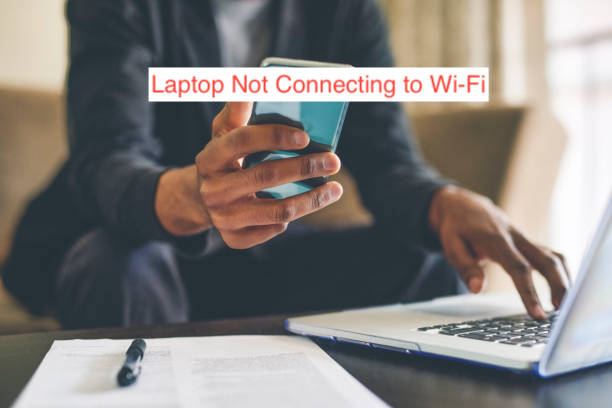When your laptop not connecting to Wi-Fi, it can be incredibly frustrating if you’re in the middle of an important project or research. There are several common causes of this issue, and they rarely require any advanced technical knowledge or skill to fix. Here’s what you need to do to fix the problem and start using your Wi-Fi connection again as quickly as possible!
How To Fix Laptop Not Connecting to Wi-Fi
- Try a different Wi-Fi network
If you can’t connect your laptop to Wi-Fi, there are a few things you can do. Try connecting on different networks or resetting your router.
Make sure your Internet service provider isn’t experiencing issues (they’ll know about any scheduled maintenance) and that other devices around you aren’t interfering with your connection. If nothing seems to work, check in with your ISP—they may troubleshoot problems remotely and get you back online.
They also might have some ideas on where else you could go if no local networks are available. And last, don’t forget to consider whether it’s time for an upgrade!
It’s easy to take our high-speed connections for granted, but as more people move online and demand more bandwidth from their providers, slowdowns are bound to happen. So it may be time for an upgrade before your current network slows down. It will save you headaches down the road!
- Update your Wi-Fi card
Having a Wi-Fi card that’s out of date or won’t update can cause your laptop to have trouble connecting. If you’re using a Mac, first make sure that Ethernet Built In is selected under Network in System Preferences.
Windows laptops will need an ethernet port and a network cable; you’ll also need to open up Control Panel and look for Ethernet (LAN) settings. Once connected via ethernet, you should be able to get Wi-Fi working on your computer by ensuring that both Ethernet and Wi-Fi are enabled, updating drivers, or re-installing them entirely.
You might also want to consider unplugging any other wireless devices nearby, as they might interfere with your internet connection.
- Update drivers
If you can’t connect your laptop to a Wi-Fi network, it may be because of an outdated driver. Check for updates by clicking on Start and then selecting the Device Manager.
This will display all devices connected to your computer, which includes any internal components like a Wi-Fi card. Right-click on any device with an exclamation mark next to it, then select Update Driver Software from the dropdown menu.
If no update is available, you may need to download a driver directly from your laptop’s manufacturer. To find out more about how manufacturers provide drivers, check out How Drivers Work in HowStuffWorks Play #6: A+. You’ll learn that many manufacturers post drivers online or provide them through a website called PC Wizard.
- Call technical support
If you can’t get online, the first thing you should do is contact your internet service provider or router manufacturer and ask them what they recommend.
If it’s a problem with your ISP, they might be able to help fix it. If not, they might be able to tell you how much a technician will cost.
Alternately, if you’re comfortable trying a more advanced solution on your own (or if you don’t have an ISP), search Google for how to connect the laptop to Wi-Fi windows 7 or connect Wi-Fi MacBook pro.
There are tons of helpful forums and tutorials out there that can help troubleshoot whatever problem you may be having. Hopefully, one of them will work for you!
If you still aren’t getting anywhere, call technical support.
They might need to go through some troubleshooting steps with you to figure out where the issue lies, but many big companies like Apple and Microsoft offer free customer service over phone calls or chat. It’s worth a shot if nothing else has worked.
Just remember that while tech support usually isn’t free—even at companies like Apple—you shouldn’t feel obligated to pay extra fees unless something goes wrong because of their advice or actions.
- Reset Wi-Fi settings
Sometimes, your laptop just can’t find your Wi-Fi signal, and you do not know why.
The first thing you should do is simply reboot your router and your computer (or phone). If that doesn’t work, you might want to reset all of your Wi-Fi settings. You can do that on Windows by clicking Start, then Control Panel > Network and Internet > View network status and tasks > Manage wireless networks.
Here, you’ll be able to disconnect from any network or reconnect with one. You can also change what sort of security is on it or turn off a particular network completely if it’s causing problems for you.
To reset your Mac’s Wi-Fi settings, click System Preferences in Finder and choose Network. Select Wi-Fi from here and click Advanced. From here, you can delete saved networks, disconnect from them or restart them manually. On an Android device, go to Settings > Wireless & Networks > Wi-Fi settings and tap Forget This Network.
For iOS devices like iPhones and iPads, go to Settings > General > Reset > Reset Network Settings. You’ll need to enter your passcode if you have one set up on your device before it will proceed with deleting saved networks and restarting your connection automatically.
- Finally, test your Wi-Fi connection
One of the easiest things you can do is troubleshoot your internet connection.
First, try restarting your router and then restarting your computer. If you still can’t connect, head over to Google and search for check my [your internet provider] connection. The tool will help diagnose any issues you may have and offer potential solutions to get you connected again as quickly as possible.
It’s a good idea to test your connection before calling tech support; after all, they don’t want you on hold for hours while they troubleshoot an issue that has nothing to do with them or their service.
A quick check might save everyone some time and frustration!
Sometimes you won’t even be able to attempt these steps—may be your provider’s website won’t load or maybe there isn’t a customer service line listed anywhere. That doesn’t mean there aren’t resources available, though.
Many providers have knowledge bases or communities dedicated to troubleshooting issues just like yours, so it never hurts to check and see if anyone else may have figured out how to fix it already.
Forums are also great places to ask questions about what exactly is going wrong so others can respond with advice specific to your issue and situation.
READ MORE: How To Fix Overheating Laptop Without Taking It Apart
Conclusion
This article has shown you how to fix laptop not connecting to Wi-Fi. Finally, keep in mind that more advanced fixes should almost always come from your ISP (or Apple), not third-party sites like ours.

